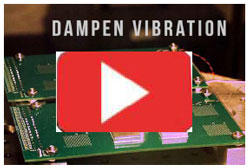FAQ - Frequently Asked Questions
PID Particle Impact Dampers |
| Nr |
Question |
Answer |
Reference |
| Q1 |
How does the PID work?. |
The motion of the tungsten particles in the PID lags the motion of the container and the board, causing the tungsten balls to impact a wall of the housing out of phase with the motion of the PCB card. This event imparts a force opposite the direction of motion at that instant; thus, minimizing the peak motion (and strain) for that cycle. |
|
| Q2 |
How does the PID require batteries or power supply?. |
Electrical power is not required. |
|
| Q3 |
Can PIDs attenuate pyroshock? |
Yes |
Ref |
| Q4 |
Is the PID effective when the PCB is oriented vertically? |
Yes |
|
| Q5 |
How much does the PID weigh? |
The mass of the moving tungsten particles inside the PID is roughly 10% of the total mass of the PCB assembly. The empty weight of the PID housing is intended to be a smaller fraction compared to the moving mass of the particles. |
|
| Q6 |
How much damping can be expected by using a PID? |
The critical damping ratio may be increased from 0.005 to more than 0.030. While this change may seem small, it can result in a significant reduction in the peak response. Damping tends to increase proportionally to the RMS excitation. |
|
| Q7 |
Where should the PID be located? |
Depending on boundary conditions, this might simply be the geometric center of the PCB. The optimal placement is at the peak response location, for the mode you wish to attenuate. This is usually (but not always) the first mode. In case of a PC board constrained on 3-sides, the optimal location might shift closer toward the free edge of the board. |
|
| Q8 |
What if the PID can not be placed at the optimal location? |
While the optimal placement of the PID is preferred, it is not absolutely required for the PCB to benefit. Sub-optimal placement may still provide sufficient damping to the PCB assembly. |
|
| Q9 |
Does the PID reduce the fundamental frequency of the PCB board? |
The main purpose of the PID is not to substantially reduce the fundamental frequency of the PCB board. At very low excitation levels, the PID will slightly lower the fundamental frequency of the PC board commensurate with the increased mass of the PID. As the excitation becomes more energetic, the tungsten particles will begin to escape gravity and will move independently of the PID housing. At this point, the tungsten particles will become a separate system that counteracts with the PC board via small forces moving opposite the prevailing response. The empty housing mass of the PID is kept as low as possible to minimize the decrease of the natural frequency of the PC board. |
|
| Q10 |
How is the PID mounted to the PCB board? |
The PID may be bonded (epoxy/adhesive) or mechanically fastened with soldering or bolting. For heritage hardware, an interposer bridge may be incorporated to lift the PID above the plane of the PC board to avoid hitting components on the board. The PID may be attached to the PCB board either on the top side or bottom side. |
|
| Q11 |
Does the PID generate heat? |
Impacts generate a small amount of heat. The PID housing was not warm to the touch even after hours of testing at high levels of excitation. |
|
| Q12 |
Is there a good way to experimentally optimize the effect of PID in the lab? |
A good way to do this is with dynamic surrogates of your hardware, having the same frequency and modal effective mass. |
Ref |
| Q13 |
Is the PID effective to attenuate vibration on light weight assemblies ≤0.5-lbs (≤227g)? |
Yes |
|


